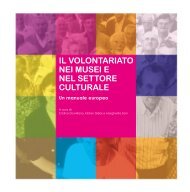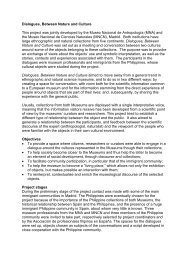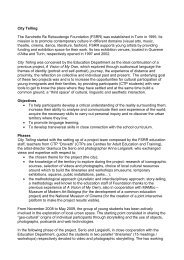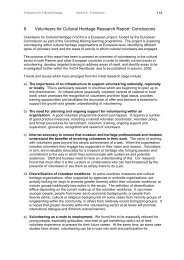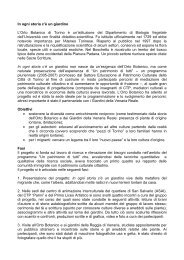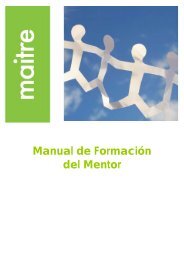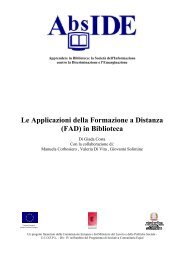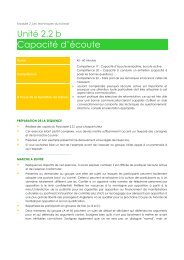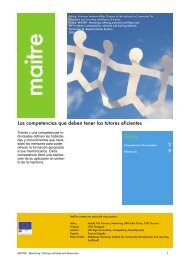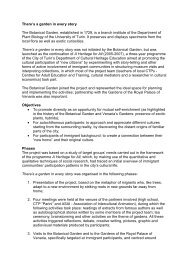Museums as places for intercultural dialogue - Network of European ...
Museums as places for intercultural dialogue - Network of European ...
Museums as places for intercultural dialogue - Network of European ...
Create successful ePaper yourself
Turn your PDF publications into a flip-book with our unique Google optimized e-Paper software.
InstitutionBotanical Garden <strong>of</strong> TurinProject coordinatorsFor the Botanical Garden:Rosanna Caramiello, Director, rosanna.caramiello@unito.itFor the working group A Heritage <strong>for</strong> All:Sandra Aloia, researcher in cultural economics, sandraaloia@katamail.comPatrizia Trebini, external consultant <strong>of</strong> local CTPs (<strong>for</strong>mer teacher),patriziatrebini@virgilio.itTarget groupsOne cl<strong>as</strong>s <strong>of</strong> immigrant students (youths and adults) from CTP “Parini;” one cl<strong>as</strong>s<strong>of</strong> students from a local high school specialising in art subjects; native and migrantusers <strong>of</strong> a community centre (ASAI – Association <strong>of</strong> Intercultural Animation) b<strong>as</strong>edin the neighbourhood <strong>of</strong> San Salvario, Turin’s multiethnic heart.There’s a garden in every storyThe Botanical Garden, established in 1729, is a branch institute <strong>of</strong> theDepartment <strong>of</strong> Plant Biology <strong>of</strong> the University <strong>of</strong> Turin. It preserves anddisplays specimens from the local flora <strong>as</strong> well <strong>as</strong> exotic curiosities.There’s a garden in every story w<strong>as</strong> not initiated by the BotanicalGarden, but w<strong>as</strong> launched <strong>as</strong> the continuation <strong>of</strong> A Heritage <strong>for</strong> All(2005-2007), a three-year programme <strong>of</strong> the City <strong>of</strong> Turin’s Department<strong>of</strong> Cultural Heritage Education aimed at promoting the culturalparticipation <strong>of</strong> “new citizens” by experimenting with story-tellingand other <strong>for</strong>ms <strong>of</strong> active involvement <strong>of</strong> immigrant communities instructuring museum visits and interpreting collections, in which most <strong>of</strong>the project team (teachers <strong>of</strong> local CTPs - Centres <strong>for</strong> Adult Educationand Training, cultural mediators and a researcher in cultural economics)took part.The Botanical Garden joined the project and represented the idealspace <strong>for</strong> planning and implementing the activities; partnership with theGardens <strong>of</strong> the Royal Palace <strong>of</strong> Venaria w<strong>as</strong> also important.Objectives• To promote diversity <strong>as</strong> an opportunity <strong>for</strong> mutual self-enrichment(<strong>as</strong> highlighted in the history <strong>of</strong> the Botanical Garden and Venaria’sGardens: presence <strong>of</strong> exotic plants, hybrids);• For autochthonous participants: to approach and appreciatedifferent cultures starting from the surrounding reality, by discoveringthe distant origins <strong>of</strong> familiar parts <strong>of</strong> the city;• For participants <strong>of</strong> immigrant background: to create a connectionbetween their “new home” and their original culture.Ph<strong>as</strong>esThe project w<strong>as</strong> b<strong>as</strong>ed on a study <strong>of</strong> target groups’ needs carried outin the framework <strong>of</strong> the programme A Heritage <strong>for</strong> All, which, by makinguse <strong>of</strong> the quantitative and qualitative techniques <strong>of</strong> social research,had traced an initial overview <strong>of</strong> immigrant communities’ participationpatterns in the city’s cultural life.There’s a garden in every story w<strong>as</strong> organised in the following ph<strong>as</strong>es:1. Presentation <strong>of</strong> the project, b<strong>as</strong>ed on the metaphor <strong>of</strong> migrants who, liketrees, adapt to a new environment by striking roots in new grounds faraway from home.2. Four meetings were held at the venues <strong>of</strong> the partners involved (highschool, CTP “Parini” and ASAI - Association <strong>of</strong> Intercultural Animation),during which the following activities took place: readings <strong>of</strong> extractsfrom famous authors <strong>as</strong> well <strong>as</strong> autobiographical stories written by somemembers <strong>of</strong> the project team; tea ceremony; brainstorming and otheractivities on the theme <strong>of</strong> gardens. All these activities triggered reflections,debate, creative writing, pictures, graphic and audiovisual materialsproduced by participants.3. Visits to the Botanical Garden and to the Gardens <strong>of</strong> the Royal Palace<strong>of</strong> Venaria, specifically targeted at immigrant participants, and centredaround histories and anecdotes on plants; participants were provided withdisposable camer<strong>as</strong> and <strong>as</strong>ked to take pictures <strong>of</strong> what they found mostf<strong>as</strong>cinating.4. Reading <strong>of</strong> extracts from Duccio Demetrio’s (a renowned expert <strong>of</strong>the autobiographical method) text Which garden are you from?Autobiographical narratives; use <strong>of</strong> a range <strong>of</strong> techniques (video, drawings,short stories) to build on the initial themes <strong>of</strong> the project. After havingworked, at school and in situ, on the narratives <strong>of</strong> others, participantsfinally discovered how to become the authors <strong>of</strong> their own life histories.5. Final event at the Botanical Garden, with exchange <strong>of</strong> project materialsbetween the different groups (pictures, videos, short stories). A small treew<strong>as</strong> planted in the “Grove” <strong>as</strong> a symbol and reminder <strong>of</strong> the experience.OutcomesThe project had a positive impact on participants in terms <strong>of</strong>:• Development <strong>of</strong> a new curiosity and interest towards “other”cultures;• Positive interpersonal relations;• Retrieving and sharing p<strong>as</strong>t emotions and experiences;• Acknowledging that the values and meanings <strong>of</strong> cultural heritage areenriched by personal perspectives;• A thorough knowledge <strong>of</strong> the Botanical Garden.On the other hand, the fact that the project team w<strong>as</strong> external to themuseum and ran the activities in its spare time on a voluntary b<strong>as</strong>is,meant that some <strong>of</strong> its members had time management difficulties.46 47



